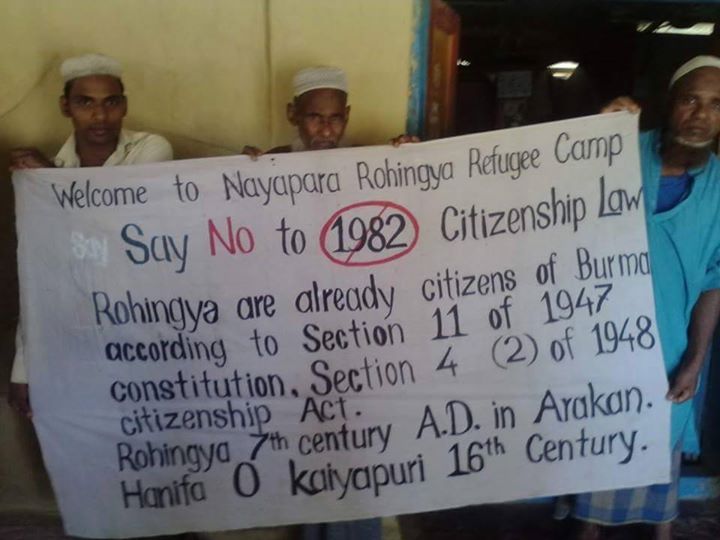Burma-Rohingyas and the Other Rohingyas -- residual cases
Submitted by moderator on
Of recent, there have been concerns raised, especially by political and social organisations from Pakistan about the plight of long-suffering Rohingyas. On 26 May 2015, the Pakistanis Foreign Office, through OIC, encourages "Myanmar authorities to take necessary measures to restore stability and launch reconciliation process". The Foreign Office has also urged the OIC Council of Foreign Ministers to assist in the rescue and rehabilitation of the displaced Rohingya Muslims.[#A]
Together with the hightened concern by Pakistanis people about the Rohingyas, these initiatives being made by the Government of Pakistan are to be warmly welcomed. Historically, Burma and Pakistan have had a very close co-operations following the decades of gaining their independence from Great Britain [#B]. A large number of Pakistanis migrants continued to reside in Arakan State as well as in proper Burma during these years. Even as of 1964, on the visit of Pakistani Foreign Minister Z. Bhutto, expressed hope that:
".. The Moslems in that portion of Arakan which adjoins with East Pakistan number about 400,000 and have lived there for generations and had acquired Burmese nationality. But they are patently of Pakistani origin.... some Pakistani cross into Arakan illegelly and mingled...... As part of drive to detect these illegal immigrants the local Burmese authorities .... employ extremely oppressive measures... The Pakistan Government is anxious that these Arakanese Moslems should not be goaded into leaving Burma and taking refuge in East Pakistan....."[#C]
During the break-up of East Pakistan, there had been in excess of 500,000 refugees who had entered Arakan. This was reported by a British diplomatic cable in 1975 that:
"..... that there were upward of a half million Bengali trespassers in Arakan whom the Burmese had some right to eject. He had implored the Burmese authorities not to press this issue during Bangladesh's present troubles and had been pleased that Burmese had not taken advantage of his country's misfortunes..."[#D]
Operation King Dragon and the "Other Rohingyas"
Obviously, when a half million aliens resisted pressure to going home [#E], the then Gen. Ne Win's government had no other civilised choice, but resorted to the threat of arrests and practical imprisonments. The Burmese Government then had launched now infamous Operation King Dragon in 1979 to flush out all these illegal Pakistanis immigrants. Void of any explanation, however, the Burmese Government voluntarily taken back the bona-fide residents of Arakan afterwards as:
"(9) According to the terms of the agreement of 11 July (1979) repatriation was to take place in three stages, first of those holding National Registration Cards, then the Foreign Registration Card holders, and finally those without documentation but with some proof of links with their Burmese village -- totalling in all about 150,000 -- 170,000. ..."[#F]
In fact, any person who can show the proof of prior residency in Arakan had been taken back by the Burmese Immigration in 1979. Those returnees, indeed, are the "Burma-Rohingyas".
Pakistan, of course, since those days became home to the largest community of exiles from Arakan -- i.e. the outcome of 1979 Operation King Dragon. The exiled community appear to call itself 'Rohingya', though their stay in Arakan, in theory, will be short in comparison to that of 'Burma-Rohingyas', those whom taken back by Burmese authorities in 1979.
Other-Rohingyas? Protesting 1982 Citizenship Laws
Pressing concerns and Greatest fear
Of latest, the pressing concern here being the plights of those 'Other-Rohingyas' who will not be accepted by Burmese authorities. Their total number 32,000 and they had been languishing in two camps, Kutupalong and Narayapara, since the exodus of 1991. The Government of Bangladesh has been planning to move this group of refugees to an island south of the country. A solution for local re-integration is unlikely, according to the UN Sources [#G].
The greatest fear is that the UNHCR will soon exercise so-called "cessation clause", for which this group of "Other-Rohingyas" will be abandoned. There is precedence by UNHCR, in particular abandoning such residual cases of which the UNHCR can no longer find a viable solution. Just in last few years, those Tamil exiles on the Indian soil, for example, were left to fend for themselves. Such abandonment entails more irregular maritime travels, more deaths at sea and more head-ache for the regional governments.
A Ray of Hope?
In this context, the latest attention from Pakistan to the plights of Rohingya can be quite timely. Government and People of Pakistan can do, in fact, more than expressing their concerns and putting forward resolutions re: Rohingyas at OIC. They can bring-in, practically, those Rohingyas whom in need of a permanent solution. Wouldn't it be a good time for those of us, the activists, imploring the Government and People of Pakistan to consider such proposal?
References:
[#A] http://nation.com.pk/national/26-May-2015/pakistan-expresses-concerns-ov...
[#B] Pakistan and Its neighbour - Burma by Hafeez-ur-Rahman Khan, Pakistan Horizon, 1961.
[#C] Confidential Letter of the British High Commissioner in Rawalpindi, Pakistan to the Common Wealth Relations Office, London, The National Archives, London, 2-SEA 60/6/1
[#D] The National Archives, London: FCO 15/2041 – C384097
